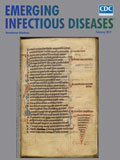
Volume 25, Number 2—February 2019
Etymologia
Etymologia: Cochliomyia hominivorax

Figure. Depicts a dorsal view of the “Primary screwworm” fly, Cochliomyia hominivorax, a member of the family Calliphoridae. Image: Public Health Image Library.
From the Greek kochlias (“snail with a spiral shell”) + myia (“fly”) and the Latin hominis (“man”) + vorax (“consuming”), Cochliomyia hominivorax, or the New World screwworm fly (formerly Callitroga [Greek kallos, “beautiful,” + trogein, “to gnaw”] americana) (Figure), was first described by French entomologist Charles Coquerel in 1858. C. hominivorax larvae enter wounds and feed on living tissue, and if untreated, infestations can be fatal. C. hominivorax was eliminated in the United States in 1982 and in much of Central America in the 1990s, although outbreaks associated with reimportations in infected humans and animals continue to occur.
References
- Dear JP. A revision of the New World chrysomyini (Diptera: Calliphoridae). Rev Bras Zool. 1985;3:109–69. DOI
Figure
Cite This ArticleOriginal Publication Date: 1/7/2019






















.png)











No hay comentarios:
Publicar un comentario